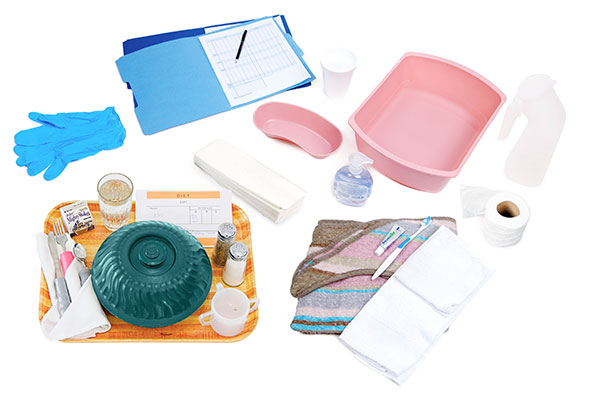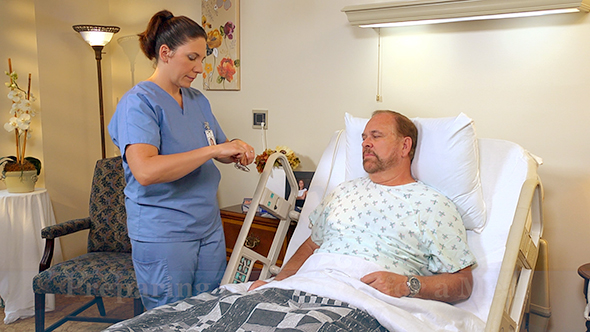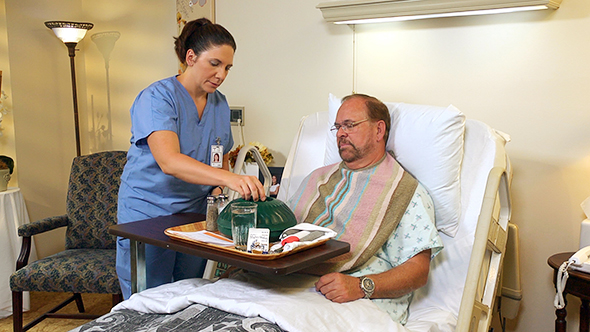Nutrition and Fluids
Select a Skill:
Take the Review Test:

Purpose

- Weakness, illness, and confusion can affect appetite and the ability to eat. So can unpleasant odors, sights, and sounds. An uncomfortable position, oral hygiene needs, elimination needs, and pain also affect appetite.
- Preparing patients and residents for meals promotes comfort.
- You serve meals after preparing patients and residents for meals. If they are ready to eat, you can serve meals promptly. Doing so keeps food at the correct temperature.
- Food is served in containers that keep foods at the correct temperature. Hot food is kept hot. Cold food is kept cold.
- Serve meals in the assigned order. In nursing centers, residents seated at tables are served at the same time.
- If food is not served within 15 minutes, re-check food temperatures. Follow agency policy. If not at the correct temperature, get fresh food. Temperature guides and food thermometers are in dining rooms and in nursing unit kitchens. Some agencies allow re-heating in microwave ovens.
Equipment
Roll cursor over items to see labels. For the purposes of clearly depicting the equipment, a barrier is not shown in this photo. When providing care, a barrier should always be placed on the surface before placing the equipment.

Gloves
Flowsheet in folder
Intake & Output record in folder
Soap and wash basin
Clothes protector
Meal tray
Paper towels
Dietary card
Napkin & Eating utensils
Water cup with cool water
Kidney basin
Toothpaste
Toothbrush
Hand towel
Urinal
Toilet tissue
Delegation
- Follow delegation guidelines. Before preparing the person for a meal, obtain this information from the nurse and care plan:
- How much help the person needs
- Where the person will eat—room or dining room
- What the person uses for elimination—bathroom, commode, bedpan, or urinal
- What type of oral hygiene the person needs
- If the person wears dentures
- If the person wears eyeglasses or hearing aids
- How to position the person—in bed, a chair, or wheelchair
- How the person gets to the dining room—by self or with help
- If the person uses a wheelchair, walker, or cane
- What observations to report and record
- When to report observations
- What patient or resident concerns to report at once
- Before serving meal trays, obtain this information from the nurse and care plan:
- The person’s food allergies, if any
- What assistive devices the person uses
- If the person needs help opening cartons, cutting food, buttering bread, and so on
- If the person’s intake is measured
- If calorie counts are done
- What observations to report and record
- When to report observations
- What patient or resident concerns to report at once
Preparation

- Observe quality-of-life measures.
- Review the information under Delegation and Safety and Comfort.
- Provide for privacy when preparing the person for a meal.
Safety

- Before meals, the person needs to eliminate and have oral hygiene. Follow Standard Precautions and the Bloodborne Pathogen Standard. Also follow them when cleaning equipment and the room.
- Always check the food temperature after re-heating. Food that is too hot can cause burns.
Comfort
- The meal setting must be free of unpleasant sights, sounds, and odors. If allowed, remove unpleasant equipment from the room.
- Check the person’s position when serving a meal. The position may have changed after the person was prepared to eat.
- Provide other comfort measures as needed.
Procedure Video
Audio Description: OFFFollow-up Care

- Provide for comfort.
- Place the call light within reach.
- Empty, clean, rinse, and disinfect equipment. Return equipment to its proper place. Wear gloves and practice hand hygiene after removing and discarding them.
- After preparing the person for a meal, straighten the room. Eliminate unpleasant noise, odors, or equipment. Unscreen the person.
- Raise or lower bed rails. Follow the care plan.
- Complete a safety check of the room.
- Follow agency policy for soiled linens.
- Practice hand hygiene.
Reporting/Recording
- Report and record your observations.
Review Questions
Select the best answer.
1. Why are patients and residents prepared for meals?
 To serve meals promptly
To serve meals promptly To allow food to cool to room temperature
To allow food to cool to room temperature To make it easier for you to feed the person
To make it easier for you to feed the person To promote social interactions among patients or residents
To promote social interactions among patients or residents
Select the best answer.
2. Before serving a meal tray, you make sure the tray is complete. What should you check its items against?
Select the best answer.
3. When you check a meal tray, what should you make sure it includes?
Select the best answer.
4. After removing the food covers on a meal tray, what should you do?
 Wash the person’s hands
Wash the person’s hands Say grace with the person
Say grace with the person Cut food into bite-sized pieces
Cut food into bite-sized pieces Taste the food and season it well
Taste the food and season it well
Select the best answer.
5. How should you position the person for a meal in bed?
 In the prone position
In the prone position In the supine position
In the supine position In the side-lying position
In the side-lying position In a comfortable position with the head of the bed elevated
In a comfortable position with the head of the bed elevated
You have completed the Review Questions for this skill. To take the Review again select the Start Over button. To proceed to another skill select from the dropdown menu. Select the Home or Back button to proceed to the next section.

